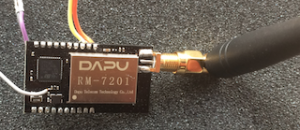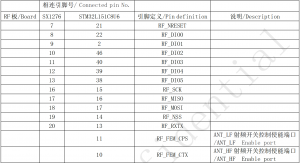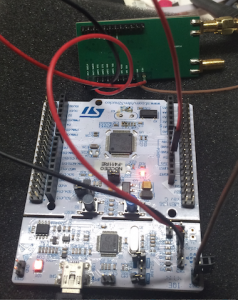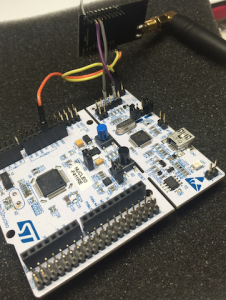During the last LoRa Alliance meeting in Rotterdam we discovered a new LoRa modules made by Shenzhen (China) based company, Dapu Telecom.
There are 4 options available, 2 radio only modules based on SX1272 and SX1276 Semtech chips and two complete modules with MCUs also based on SX1272 and SX1276 called respectively RM7201 and RM7601.
For this exercise, we obtained radios with MCUs. One important note, there is no specific part number for EU, Asia or North America. According to Dapu, the software stack will set the radio into the respective ISM band for your region. This requires further investigation, as small hardware changes between EU and North America (RF part) are present in Semtech’s reference designs.
Here is the RM7601 with MCU and SX1276 radio chip

This is theRM7201 with MCU and SX1272 radio chip

Both of them use the same MCU – STM32L151C8U6, only the radio is different as mentioned above.
If you go to the official Semtech git repository and look at their demo code, you will find out that Semtech uses the STM32L151 MCU series as well, just using a different variant of this MCU. This will most likely allow us to port the Semtech LoraWan stack to DAPU hardware with minimal effort.
First, let’s try the “big one” – RM7601.
Get the latest source code for the Semtech LoRaWan stack from https://github.com/Lora-net/LoRaMac-node or just download the latest zip file from https://github.com/Lora-net/LoRaMac-node/archive/master.zip.
Store the source code onto your local hard drive, let’s say C:\LORA\ and unzip it, then go to C:\LORA\LoRaMac-node-master\Keil\SensorNode\LoRaMac\classA, use Keil5 (i used Keil5.17 lasted one) to open the project. Why “SensorNode” demo code? because that code uses the same MCU as one used in RM7601 module.
As Semtech used Keil4 to create the LoRaWAN demo code, Keil will first migrate the project to Keil5 when you first open it, just allow it do to so.
In the RM7601 data sheet for the SX1276 radio chip we see the following pin definitions:

following this table, we can quickly change the Semtech source code and update pin definitions in C:\LORA\LoRaMac-node-master\src\boards\SensorNode\board.h to the following pins as follows:
/* * Board MCU pins definitions */ #define RADIO_RESET PB_10 #define RADIO_MOSI PA_7 #define RADIO_MISO PA_6 #define RADIO_SCLK PA_5 #define RADIO_NSS PA_4 #define RADIO_DIO_0 PB_11 #define RADIO_DIO_1 PC_13 #define RADIO_DIO_2 PB_9 #define RADIO_DIO_3 PB_4 #define RADIO_DIO_4 PB_3 #define RADIO_DIO_5 PA_15 #define RADIO_ANT_SWITCH_HF PA_0 #define RADIO_ANT_SWITCH_LF PA_1 #define OSC_LSE_IN PC_14 #define OSC_LSE_OUT PC_15 #define OSC_HSE_IN PH_0 #define OSC_HSE_OUT PH_1
The most important ones are the SPI bus 4 wires and radio DIO_0 to DIO_5 definitions, just make sure that you have correct pin definition in your code.

Change the main.c file to join the gateway using OTA mode:
#define OVER_THE_AIR_ACTIVATION 1
add the AppEUI, DevEUI and AppKey based on your gateway settings, here is what I did:
#define LORAWAN_DEVICE_EUI { 0x01, 0x23, 0x45, 0x67, 0x89, 0xAB, 0xCD, 0xEF }
#define LORAWAN_APPLICATION_EUI { 0xc0, 0xff,0xee, 0x00, 0x00, 0x00,0x00,0x02 }
#define LORAWAN_APPLICATION_KEY { 0x2B, 0x7E, 0x15, 0x16, 0x28, 0xAE, 0xD2, 0xA6, 0xAB, 0xF7, 0x15, 0x88, 0x09, 0xCF, 0x4F, 0x3C }
Please pay attention, the AppEUI is reversed (LSB ENDIANNESS).
As my LoRa Gateway is running at 915Mhz frequency, I changed the compiler option to “Loramac-915”. It is important and don’t forget to set this for properly your region.
Here are my gateway settings:
root@mtcdt:~# cat /var/config/lora/lora-network-server.conf
{
"lora": {
"netID": "010203", /* netID for beacon packets */
"frequencyBand": "915", /* US="915", EU="868" */
"frequencySubBand": 1, /* Sub-band for US operation, 1-8 */
"rx1DatarateOffset": 0, /* Datarate offset for mote rx window 1 sent in join response (0-3) */
"rx2Datarate": 12, /* Datarate for mote rx window 2 sent in join response (7-12) */
"maxTxPower": 26, /* Max Tx power (dBm), -6 to 26 */
"frequencyEU": 867500000 /* center freq for extra EU channels (Hz) */
},
"udp": {
"appPortUp": 1784, /* port for user-developed application use */
"appPortDown": 1786 /* port for user-developed application use */
},
"addressRange": {
"start": "00:00:00:01", /* address range used for mDots */
"end": "FF:FF:FF:FE"
},
"network": {
"public": true, /* set to false for private LoRa network with mDots + Conduit */
"leasetime": 1440, /* time until mDot join expires (minutes) */
"eui": "02:00:00:00:00:ee:ff:c0", /* configure network security */
"key": "2b:7e:15:16:28:ae:d2:a6:ab:f7:15:88:09:cf:4f:3c"
},
"log" : {
"console" : true,
"syslog" : false,
"level" : 100, /* error=10, warn=20, info=30, debug=50, trace=60, max=100 */
"path": "/var/log/lora-network-server.log"
},
"mqtt": {
"enabled": true
}
}
Compile the code and flash it to the RM7601, then login via ssh into your gateway and watch for our updated module to join the gateway. For help on how to set up the Multi-tech gateway, please follow our blog posts:
$ ssh -l root 192.168.1.181
root@mtcdt:~# tail -f /var/log/lora-network-server.log
8:19:36:716|DEBUG| Received packet
================================
000 00 c0 ff ee 00 00 00 00
008 02 01 23 45 67 89 ab cd
010 ef 27 9b 5f f0 dd d1
8:19:36:717|DEBUG| Rx on 903700000, rssi: -27 snr: 98
8:19:36:717|DEBUG| Received frame: type: Join Request
8:19:36:717|INFO| Received join request
8:19:36:718|DEBUG| BUFFER: 00c0ffee00000000020123456789abcdef279b
8:19:36:718|DEBUG| App EUI: 02.00.00.00.00.ee.ff.c0
8:19:36:718|DEBUG| Dev EUI: ef.cd.ab.89.67.45.23.01
8:19:36:719|DEBUG| Nonce: 00009b27
8:19:36:719|DEBUG| MIC is valid
8:19:36:720|DEBUG| Got appkey: 2b.7e.15.16.28.ae.d2.a6.ab.f7.15.88.09.cf.4f.3c
8:19:36:720|DEBUG| DEV NONCE: 9b27
8:19:36:720|DEBUG| APP NONCE: 3be317
8:19:36:721|DEBUG| session keys: bac1a83854b7545eec7e3df4f305991d 9839190af648989e6d344ac5078cc4ce
8:19:36:721|TRACE| SQL query = SELECT address FROM nodes WHERE deveui = "efcdab8967452301"
8:19:36:723|INFO| Device found in DB, assigning address: 7
8:19:36:723|DEBUG| Update session keys
8:19:36:724|TRACE| SQL query = UPDATE nodes SET authenticationkey = "bac1a83854b7545eec7e3df4f305991d", encryptionkey = "9839190af648989e6d344ac5078cc4ce" WHERE address = "00000007"
8:19:36:727|DEBUG| Set node active: 1
8:19:36:727|INFO| Queue join response 17 bytes
8:19:36:728|DEBUG| Set node active: 1
8:19:36:728|DEBUG| update bestGateway
8:19:36:728|DEBUG| Time: 39995444
8:19:36:728|DEBUG| App Queue Length: 1
8:19:36:729|DEBUG| Rx Frame seq 0 snr 98
8:19:36:729|DEBUG| SpreadingFactorStore::Add
8:19:36:729|DEBUG| FindSF : snr : 98 100 -2
8:19:36:731|TRACE| SQL query = UPDATE nodes SET jointime = "2015-12-21T08:19:36Z" WHERE address = "00000007"
8:19:36:734|TRACE| SQL query = UPDATE packets SET port = 2, seqno = 0, gateway = "0080000000009f6c", time = "2015-12-21T08:19:36Z", microseconds = 713268000, rssi = -27, channel = 7, lsnr_cB = 98, spread = 10, modulationbandwidth = 125, data = "0123456789abcdef279b" WHERE node = "00000007"
8:19:36:738|TRACE| SQL query = UPDATE nodes SET lastuppacketid = 1, lastmessagems = 51204 WHERE address = "00000007"
8:19:36:740|TRACE| SQL query = UPDATE gateways SET lastuppacketid = 1 WHERE address = "0080000000009f6c"
8:19:36:743|DEBUG| getTimeOnAirMs dr: 10 bw: 2 pl: 8 sz: 16 toa: 82
8:19:36:744|INFO| Send Join Accept - EUI: ef:cd:ab:89:67:45:23:01 ADDR: 00000007
8:19:36:744|INFO| Schedule TX Time on air: 150 ms
8:19:36:752|DEBUG| Send MQTT message
8:19:36:753|DEBUG| UDP message: lora/ef:cd:ab:89:67:45:23:01/joined
8:19:36:753|DEBUG| UDP port: 1784
8:19:36:756|TRACE| Published message: 2
8:19:37:266|TRACE| Parse downstream message 12 bytes
8:19:37:267|TRACE| Gateway 00:80:00:00:00:00:9f:6c seen IP address 127.0.0.1:33742
8:19:41:597|DEBUG| is frame ready?
8:19:41:597|DEBUG| App Queue Length: 1
8:19:41:597|DEBUG| BestGateway: 80000000009f6c
8:19:41:598|DEBUG| Start
8:19:41:598|INFO| Frame transmitted to 00:00:00:07 via GW (00:80:00:00:00:00:9f:6c Chan FC1 127.0.0.1:33742) Seq# 2
8:19:41:599|TRACE| SQL query = UPDATE nodes SET lastdownmsgseqno = 2 WHERE address = "00000007"
8:19:41:602|DEBUG| App Data Queue: 1 front size: 17 available: 242
8:19:41:602|DEBUG| check if front is join request 17 bytes
8:19:41:602|DEBUG| Start
8:19:41:603|TRACE| App Data Queue - Join Popped
8:19:41:603|DEBUG| Transmitted Frame data
================================
000 20 9f aa ac 1f ac d7 bc
008 e5 aa 44 0d 7e ca 24 8a
010 dd
8:19:41:603|DEBUG| rx1Offset: 0 rx1Datarate: 10
8:19:41:604|DEBUG| Use JoinResponse Window Time
8:19:41:606|DEBUG| JSON tx: {
"txpk" : {
"codr" : "4/5",
"data" : "IJ+qrB+s17zlqkQNfsokit0",
"datr" : "SF10BW500",
"freq" : 927.5,
"ipol" : true,
"modu" : "LORA",
"ncrc" : false,
"powe" : 26,
"rfch" : 0,
"size" : 17,
"tmst" : 44995444
}
}
Seems that everything worked right away and we’ve joined the gateway!
There are a few parameters we can verify in the gateway log above, which are marked in bold.
Next, let’s try the “small one” – RM7201.
The RM7201 uses same MCU as the RM7601, just the RF radio is different, SX1272 instead of SX1276. For both the SX1276 and SX1272 data sheets, check the Semtech website: http://www.semtech.com/apps/product.php?pn=sx1272&x=0&y=0 http://www.semtech.com/wireless-rf/rf-transceivers/sx1276/ and http://www.semtech.com/apps/product.php?pn=sx1272&x=0&y=0.
As with RM7601, I expected simply changes in the config files, but unfortunately, it was not that easy . At the beginning, I’ve tried to use the same project – NodeSensor, but I quickly found out that I would have to port the SX1272 driver as this project does not include support for the SX1272. Porting the SX1272 driver should be easy as most likely it would involve just changing some header definitions. However, after looking deeper into Semtech code, I found another project which does have support for the SX1272, the Loramote project.
As the RM7201 uses a smaller header, my connector would not fit, so i soldered 4 wires (SWCLK, SWIO, VDD and GND) to the RM7201 module directly:

Change the board.h definition as follows:
/*! * Board MCU pins definitions */ #define RADIO_RESET PB_10 #define RADIO_MOSI PA_7 #define RADIO_MISO PA_6 #define RADIO_SCLK PA_5 #define RADIO_NSS PA_4 #define RADIO_DIO_0 PB_11 #define RADIO_DIO_1 PC_13 #define RADIO_DIO_2 PB_9 #define RADIO_DIO_3 PB_4 #define RADIO_DIO_4 PB_3 #define RADIO_DIO_5 PA_15 #define RADIO_ANT_SWITCH_RX PA_0 #define RADIO_ANT_SWITCH_TX PA_1 #define OSC_LSE_IN PC_14 #define OSC_LSE_OUT PC_15 #define OSC_HSE_IN PH_0 #define OSC_HSE_OUT PH_1 #define USB_DM PA_11 #define USB_DP PA_12
Now use ssh to login to the gateway again and watch the log output:
root@mtcdt:~# tail -f /var/log/lora-network-server.log
9:12:53:3|DEBUG| Received packet
================================
000 00 c0 ff ee 00 00 00 00
008 02 01 63 34 73 38 31 38
010 32 23 3c 52 a9 11 90
9:12:53:3|DEBUG| Rx on 902300000, rssi: -61 snr: 58
9:12:53:4|DEBUG| Received frame: type: Join Request
9:12:53:4|INFO| Received join request
9:12:53:4|DEBUG| BUFFER: 00c0ffee00000000020163347338313832233c
9:12:53:5|DEBUG| App EUI: 02.00.00.00.00.ee.ff.c0
9:12:53:5|DEBUG| Dev EUI: 32.38.31.38.73.34.63.01
9:12:53:5|DEBUG| Nonce: 00003c23
9:12:53:6|DEBUG| MIC is valid
9:12:53:6|DEBUG| Got appkey: 2b.7e.15.16.28.ae.d2.a6.ab.f7.15.88.09.cf.4f.3c
9:12:53:7|DEBUG| DEV NONCE: 3c23
9:12:53:7|DEBUG| APP NONCE: 2f529e
9:12:53:7|DEBUG| session keys: 99e47e148873a6e32ceff9a3eccd2233 96f44cb0d5c2a3900aaf20e9ef8f931b
9:12:53:8|TRACE| SQL query = SELECT address FROM nodes WHERE deveui = "3238313873346301"
9:12:53:9|INFO| Device found in DB, assigning address: 5
9:12:53:10|DEBUG| Update session keys
9:12:53:10|TRACE| SQL query = UPDATE nodes SET authenticationkey = "99e47e148873a6e32ceff9a3eccd2233", encryptionkey = "96f44cb0d5c2a3900aaf20e9ef8f931b" WHERE address = "00000005"
9:12:53:13|DEBUG| Set node active: 1
9:12:53:13|INFO| Queue join response 17 bytes
9:12:53:13|DEBUG| Set node active: 1
9:12:53:14|DEBUG| update bestGateway
9:12:53:14|DEBUG| Time: 3236312956
9:12:53:14|DEBUG| App Queue Length: 1
9:12:53:14|DEBUG| Rx Frame seq 0 snr 58
9:12:53:15|DEBUG| SpreadingFactorStore::Add
9:12:53:15|DEBUG| FindSF : snr : 58 100 -42
9:12:53:15|TRACE| SQL query = UPDATE nodes SET jointime = "2015-12-21T09:12:53Z" WHERE address = "00000005"
9:12:53:19|TRACE| SQL query = UPDATE packets SET port = 2, seqno = 0, gateway = "0080000000009f6c", time = "2015-12-21T09:12:53Z", microseconds = 308000, rssi = -61, channel = 0, lsnr_cB = 58, spread = 10, modulationbandwidth = 125, data = "0163347338313832233c" WHERE node = "00000005"
9:12:53:22|TRACE| SQL query = UPDATE nodes SET lastuppacketid = 1, lastmessagems = 35856598 WHERE address = "00000005"
9:12:53:25|TRACE| SQL query = UPDATE gateways SET lastuppacketid = 1 WHERE address = "0080000000009f6c"
9:12:53:28|DEBUG| getTimeOnAirMs dr: 10 bw: 2 pl: 8 sz: 16 toa: 82
9:12:53:28|INFO| Send Join Accept - EUI: 32:38:31:38:73:34:63:01 ADDR: 00000005
9:12:53:28|INFO| Schedule TX Time on air: 150 ms
9:12:53:36|DEBUG| Send MQTT message
9:12:53:37|DEBUG| UDP message: lora/32:38:31:38:73:34:63:01/joined
9:12:53:37|DEBUG| UDP port: 1784
9:12:53:39|TRACE| Published message: 6
9:12:53:446|TRACE| Parse downstream message 12 bytes
9:12:53:447|TRACE| Gateway 00:80:00:00:00:00:9f:6c seen IP address 127.0.0.1:33742
9:12:57:885|DEBUG| is frame ready?
9:12:57:886|DEBUG| App Queue Length: 1
9:12:57:888|DEBUG| BestGateway: 80000000009f6c
9:12:57:889|DEBUG| Start
9:12:57:891|INFO| Frame transmitted to 00:00:00:05 via GW (00:80:00:00:00:00:9f:6c Chan LC1 127.0.0.1:33742) Seq# 40
9:12:57:891|TRACE| SQL query = UPDATE nodes SET lastdownmsgseqno = 64 WHERE address = "00000005"
9:12:57:894|DEBUG| App Data Queue: 1 front size: 17 available: 242
9:12:57:894|DEBUG| check if front is join request 17 bytes
9:12:57:894|DEBUG| Start
9:12:57:895|TRACE| App Data Queue - Join Popped
9:12:57:895|DEBUG| Transmitted Frame data
================================
000 20 68 6f ed 76 ea 07 12
008 bd 79 15 dc 99 53 b3 4c
010 cf
9:12:57:896|DEBUG| rx1Offset: 0 rx1Datarate: 10
9:12:57:896|DEBUG| Use JoinResponse Window Time
9:12:57:898|DEBUG| JSON tx: {
"txpk" : {
"codr" : "4/5",
"data" : "IGhv7XbqBxK9eRXcmVOzTM8",
"datr" : "SF10BW500",
"freq" : 923.29999999999995,
"ipol" : true,
"modu" : "LORA",
"ncrc" : false,
"powe" : 26,
"rfch" : 0,
"size" : 17,
"tmst" : 3241312956
}
}
and….I can confirm that RM7201 is also operational and registered with my LoRa Gateway.
Again, I have some reservations due to luck of any usable sample code from Dapu as well as a single hardware design for all regions.
You, should also confirm if all necessary approvals are actually available for your region.



